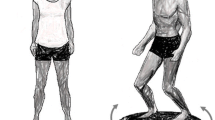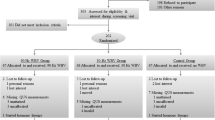Abstract
Non-pharmacologic approaches to prevent bone loss are well suited for elderly patients to avoid polypharmacy and medication side effects. One potential treatment is a vibrating platform that delivers low-level mechanical loading stimulating bone remodeling. However, compliance is a major concern with any daily treatment, and is unknown for an elderly group using this device. Thus we assessed compliance with standing 10 min/day on a vibrating platform device in elderly women, the target population for osteoporosis therapy. We also assessed satisfaction with daily use of the device. We conducted a randomized, placebo-controlled, double-blinded 6-month study for daily use of a 10-min vibrating platform treatment in elderly women who were residents of a Continuing Care Retirement community. Compliance for each subject was calculated as the number of days attended divided by the 182 days in the 6-month trial. The 24 elderly women (mean age 86, range 79–92 years) had 83% compliance (95% CI: 70.5, 94.5) for daily treatment over 6 months. Excluding three study drop-outs, the 21 women had 93% compliance (95% CI: 89.8, 95.6), with no difference in compliance between active and placebo treatment. Main reasons for missing treatment days over the 6 months were vacation (54% of missed days) and illness (29%). Three adverse events occurred; one (syncope) was possibly related to device use, whereas the other two were not related to device use. Among participants, 95% reported overall satisfaction with daily use of the vibrating platform, and 57% preferred the platform versus daily oral medications for prevention of bone loss. Elderly women showed high compliance, high satisfaction and few adverse experiences with a daily non-pharmacological treatment designed to inhibit bone loss. Larger randomized controlled trials should evaluate the long-term efficacy of vibrating platform devices for treatment of low bone mass and osteoporosis in elderly individuals.



Similar content being viewed by others
References
NIH Consensus Development Panel (2001) Osteoporosis prevention, diagnosis, and therapy. JAMA 285:785–795
Kanis J and the World Health Organization Study Group (1994) Assessment of fracture risk and its applications to screening for postmenopausal osteoporosis: synopsis of a WHO report. Osteoporos Int 4:368–381
Melton LJ (1995) How many women have osteoporosis now? J Bone Miner Res 10:175–177
Jacobsen SJ, Goldberg J, Miles TP et al. (1990) Hip fracture incidence among the old and very old: a population-based study of 745,435 cases. Am J Public Health 80:871–873
Looker AC, Johnston CC Jr, Wahner HW et al. (1995) Prevalence of low femoral bone density in older US women from NHANES III. J Bone Miner Res 10:1–7
Lacey JV Jr, Mink PJ, Lubin JH et al. (2002) Menopausal hormone replacement therapy and risk of ovarian cancer. JAMA 288:334–341
Whyte MP, Wenkert D, Clements KL, McAlister WH, Mumm S (2003) Bisphosphonate-induced osteopetrosis. N Engl J Med 349:457–463
Williams CM (2002) Using medications appropriately in older adults. Am Fam Phys 66:1917–1924
Stewart RB, Cooper JW (1994) Polypharmacy in the aged. Practical solutions. Drugs Aging 4:449–461
Delmas PD (2002) Treatment of postmenopausal osteoporosis. Lancet 359:2018-2026
Nelson ME, Fiatarone MA, Morganti CM et al. (1994) Effects of high-intensity strength training on multiple risk factors for osteoporotic fractures. A randomized controlled trial. JAMA 272:1909–1914
Fiatarone MA, Marks EC, Ryan ND et al. (1990) High-intensity strength training in nonagenarians. Effects on skeletal muscle. JAMA 263:3029–3034
Kannus P, Parkkari J, Niemi S, et al. (2000) Prevention of hip fracture in elderly people with use of a hip protector. N Engl J Med 343:1506–1513
Hughes SG (1998) Prescribing for the elderly patient: why do we need to exercise caution? Br J Clin Pharmacol 46:531–533
Inouye SK, Bogardus ST Jr, Williams CS, Leo-Summers L, Agostini JV (2003) The role of adherence on the effectiveness of nonpharmacologic interventions: evidence from the delirium prevention trial. Arch Int Med 163:958–964
Rubin CT, Turner AS, Bain S, Mallinckrodt C, McLeod KJ (2001) Anabolism: low mechanical signals strengthen long bones. Nature 412:603–604
Rubin C, Turner AS, Mallinckrodt C et al. (2002) Mechanical strain, induced noninvasively in the high-frequency domain, is anabolic to cancellous bone, but not cortical bone. Bone30:445–452
Rubin C, Xu G, Judex S (2001) The anabolic activity of bone tissue, suppressed by disuse, is normalized by brief exposure to extremely low-magnitude mechanical stimuli. FASEB J 15:2225–2229
Rubin CT, Turner AS, Muller R et al. (2002) Quantity and quality of trabecular bone in the femur are enhanced by a strongly anabolic, noninvasive mechanical intervention. J Bone Miner Res 17:349–357
John V, Mashru S, Lichtman S (2003) Pharmacological factors influencing anticancer drug selection in the elderly. Drugs Aging 20:737–759
Scales R, Miller JH (2003) Motivational techniques for improving compliance with an exercise program: skills for primary care clinicians. Curr Sports Med Rep 2:166–172
Neutel JM, Smith DH (2003) Improving patient compliance: a major goal in the management of hypertension. J Clin Hypertens (Greenwich) 5:127–132
Rubin C, Recker R, Cullen D et al. (2004) Prevention of post-menopausal bone loss by a low magnitude, high frequency mechanical stimuli; a clinical trial assessing compliance, efficacy and safety. J Bone Miner Res 19:343–351
Huang RP, Rubin CT, McLeod KJ (1999) Changes in postural muscle dynamics as a function of age. J Gerontol 54A:B352–357
Rubin CT, Bain SD, McLeod KJ (1992) Suppression of the osteogenic response in the aging skeleton. Calcif Tissue Int 50:306–315
Fritton SP, McLeod KJ, Rubin CT (2000) Quantifying the strain history of bone: spatial uniformity and self-similarity of low-magnitude strains. J.Biomech 33:317–325
Fritton JC, Rubin CT, Qin YX, McLeod KJ (1997) Whole body vibration in the skeleton: development of a resonance based device. Ann Biomed Eng 25:831–839
Rubin C, Pope M, Fritton J et al. (2003) Transmissibility of 15–35 Hz vibrations to the human hip and lumbar spine: determining the physiologic feasibility of delivering low-level, anabolic mechanical stimuli to skeletal regions at greatest risk of fracture due to osteoporosis. Spine 28:2621–2627
Ward K, Alsop C, Caulton J et al. (2004) Low magnitude mechanical loading is osteogenic in children with disabling conditions. J Bone Miner Res 19:360–369
Rubin CT, Judex S, McLeod KJ, Qin Y (2001) Inhibition of osteopenia by biophysical intervention. In Marcus R, Feldman D, Kelsey J (eds) (2001) Osteoporosis, 2nd edition, volume 1. Academic Press, San Diego, pp 489–507
Qin YX, Rubin CT, McLeod KJ (1998) Nonlinear dependence of loading intensity and cycle number in the maintenance of bone mass and morphology. J Orthop Res 16:482–489
Washburn R, Smith K, Jette A, Janney C (1993) The physical-activity scale for the elderly (PASE)-development and evaluation. J Clin Epidemiol 46:153–162
Stewart RB (1991) Noncompliance in the elderly: is there a cure? Drugs Aging 1:163–167
Colley CA, Lucas LM (1993) Polypharmacy: the cure becomes the disease. J Gen Int Med 8:278–283
Horwitz RI, Horwitz SM (1993) Adherence to treatment and health outcomes. Arch Int Med 153:1863–1868
Montamat SC, Cusack BJ, Vestal RE (1989) Management of drug therapy in the elderly. N Engl J Med 321:303–309
Monane M, Bohn RL, Gurwitz JH et al. (1996) Compliance with antihypertensive therapy among elderly Medicaid enrollees: the roles of age, gender, and race. Am J Public Health 86:1805–1808
Gallagher RM, Kunkel R (2003) Migraine medication attributes important for patient compliance: concerns about side effects may delay treatment. Headache 43:36–43
Young DJ (2003) Beyond single and dual diagnosis in general practice: patients who do not comply with polypharmacy may be safer (letter). BMJ 326:1145
Biskobing DM, Novy AM, Downs R Jr (2002) Novel therapeutic options for osteoporosis. Curr Opin Rheumatol 14:447–452
McClung B, McClung M (2001) Pharmacologic therapy for the treatment and prevention of osteoporosis. Nurs Clin N Am 36:433–440
Hauselmann HJ, Rizzoli R (2003) A comprehensive review of treatments for postmenopausal osteoporosis. Osteoporos Int 14:2–12
Pauler DK, Gower KB, Goodman PJ, Crowley JJ, Thompson IM (2002) Biomarker-based methods for determining noncompliance in a prevention trial. Control Clin Trials 23:675–685
Wilcox S, Shumaker SA, Bowen DJ et al. (2001) Promoting adherence and retention to clinical trials in special populations: a women’s health initiative workshop. Control Clin Trials 22:279–289
Jenkins KR, Pienta AM, Horgas ALRoA (2002) Activity and health-related quality of life in continuing care retirement communities. Res Aging 24:124–130
Wendel VI, Durso SC, Remsburg RE (2001) Studying coronary artery disease in the retirement community. Nurse Pract 26:48–55
Acknowledgements
We are grateful to the VIBES Study participants and staff at Orchard Cove and HRCA Research & Training Institute, especially the study interviewer, Barbara Hopkins, device monitor, Robert McLean, and programmer, Corinna Andiel. Thanks are extended to Jack Ryaby of Exogen, Inc. a subsidiary of Smith & Nephew, Inc., for the loan of the vibrating platform devices for this trial, and to Tommy Wilson, Joan McCabe and Roger Talish for technical support. This work was supported by grant RO1-AR47368 from the National Institute of Arthritis, Musculoskeletal and Skin Diseases, with equipment provided by Exogen, Inc., N.J., USA, a wholly owned subsidiary of Smith & Nephew Orthopaedics, Inc. USA. The clinical investigation described in this paper involves a non-significant risk device as defined by the Investigational Device Exemption Regulations of the United States Food and Drug Administration (FDA).
Presented in part as abstracts at the 2003 American Geriatrics Society meeting in Baltimore MD and International Bone Society Meetings in Osaka, Japan.
Dr. Clinton Rubin has served as a consultant for Smith & Nephew Orthopaedics, and is one of the inventors of the mechanical stress system technology.
Conflict of interest:
No information supplied.
Author information
Authors and Affiliations
Corresponding author
Rights and permissions
About this article
Cite this article
Hannan, M.T., Cheng, D.M., Green, E. et al. Establishing the compliance in elderly women for use of a low level mechanical stress device in a clinical osteoporosis study. Osteoporos Int 15, 918–926 (2004). https://doi.org/10.1007/s00198-004-1637-y
Received:
Accepted:
Published:
Issue Date:
DOI: https://doi.org/10.1007/s00198-004-1637-y




